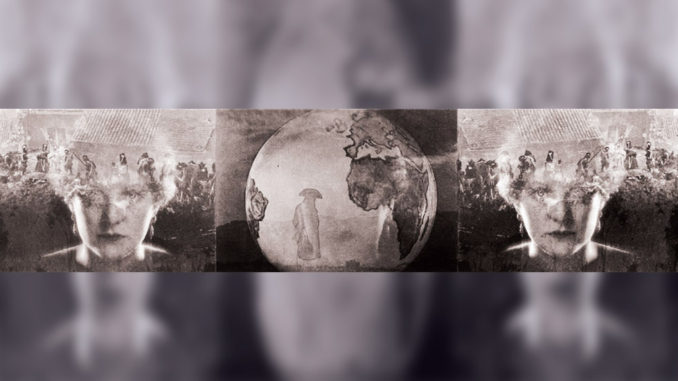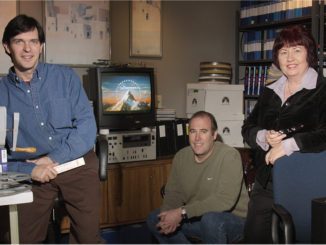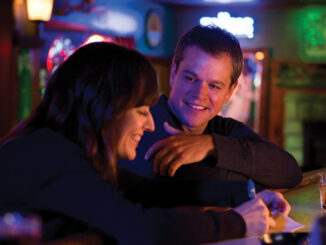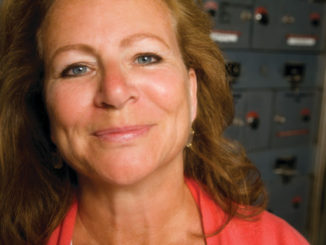
by Kevin Lewis
Napoléon vu par Abel Gance has had as many comebacks as the conqueror it portrayed, yet has always remained Waterloo-proof. Its 1981 engagement at Radio City Music Hall created a sensation over a half-century after its premiere in Paris in April 1927. For decades, Napoléon was a legend mainly because it was butchered and cannibalized. It was originally silent, around six hours in length (no one knows for certain), and only covered the first part of Napoléon’s military career, up to the Italian campaign. The other six parts were never produced.
Because of the Polyvision projection process, Napoléon could only be shown in selected cities in the late 1920s. The process was developed by Andre Debrie for filmmaker Abel Gance, who utilized a triptych, or three-panel screen, to show both widescreen vistas and separate images using three 35mm film projectors side-by-side. Polyvision would foreshadow Cinerama by some 30 years and influence such varied films as Stanley Donen’s It’s Always Fair Weather (1955) and Michael Wadleigh’s Woodstock (1970).
Perhaps no one who did not see Napoléon at its premiere showings can appreciate Gance’s original conception, because he reworked the material and the editing over the years, discarding footage and filming new scenes. Anticipating the sound revolution, he had a full dramatic script, which the actors mouthed during the original 18-month shoot. When sound did come along, he hired the original actors to record the dialogue for the soundtrack. However, that version of the film was much shorter. MGM also imported the film for a 1929 US release, but it was further truncated and did not use the Polyvision process.
Within just a few years, Napoléon ceased to exist in its original form. In 1934, Gance even released a stereophonic sound version, which was not only re-cut but re-imagined. A 17-reel version (around four hours), cobbled together by the Cinémathèque Française, inspired a generation of New Wave filmmakers in France in the 1950s. In the next decade, the French government gave funds for another sound version, titled Bonaparte and the Revolution (1969)––to be directed by the then nearly 80-year-old Gance––which used some original footage and many new scenes but no triptychs.
Gance had been very influenced by the spectacles of D.W. Griffith (Intolerance, 1916; Orphans of the Storm, 1921), especially the complex editing and compositions. Both directors created imagery derived from neoclassical, romantic and academic painting, and used close-ups of details and visual metaphors (such as the symbol of an eagle to represent Napoléon) to advance their narratives in indelible psychological terms. Like Griffith, who constantly re-cut his films so that there are many surviving re-edited versions, Gance was never satisfied with his original work.

The film’s cumulative effect derives from dynamic, audacious and relentless editing and photographic techniques rather than from conventional, historical dramatic principles. Napoléon (Albert Dieudonne) and the other notable figures of the French Revolution are shown as historically accurate collision-course rivals on a moving canvas.
To achieve the communion between the characters and the viewer, Gance utilized the new portable Debrie Photocine Parvo cameras (which were often strapped to the cameraman’s chest), as well as Sept cameras. These cameras enabled him to create extremely realistic documentary effects, which anticipated Direct Cinema and handheld camera techniques. He tied the camera to the saddle of a galloping horse to show the flight of Napoléon and the retreating landscape, and threw it in a waterproof case from a cliff into the Mediterranean Sea to show how Napoléon escaped by diving into the sea.
During the film’s scenes at the national Paris Convention in Paris, the audience felt the tumult of the opposing Girondist and Jacobin forces, thanks to the camera’s swaying forward and back on a pendulum. Gance juxtaposed these fighting masses with shots of Napoléon attempting to cross a swelling sea in a small boat, using the same handheld technique.
The triptychs are as spectacular as fireworks because of his intercutting of tinted, widescreen battle scenes with three separate images––such as the army on the side panels and a huge close-up of Napoléon in the center to create a blue, white and red tricolor finale, or a double exposure of Josephine’s head over a battle scene depicted on the side panels with the planet Earth bearing a silhouette of Napoléon on it in the center.
Napoléon would not have remained a legend without the extraordinary efforts of film historian and documentary filmmaker Kevin Brownlow, who spent over a decade canvassing film archives around the world for the missing or stored footage, some of which was in the Cinémathèque Française. This, of course, led to even more versions of the film. By 1979, Brownlow had assembled a roughly six-hour print, which he sold to the British Film Institute.
The film’s cumulative effect derives from dynamic, audacious and relentless editing and photographic techniques.
When Brownlow and Gance (who was then 90) showed the reconstructed epic at the Telluride Film Festival in 1979, producers Robert Harris and Francis Ford Coppola approached them and convinced them to agree to an American release of a full-scale theatrical presentation of Napoléon through Coppola’s company, Zoetrope. However, the film had to be projected at 24 frames per second––sound speed––rather than the original speed of 18 to 20 fps, and had to lose a few reels to bring the six-hour film down to a four-hour running time to fit the Radio City slot for its American premiere. That truncated version was subsequently shown on the US tour of major cities in 1981.
Brownlow eventually found even more footage, and a definitive version of the film was deposited with the Cinémathèque Française in 1983. Alternate versions of the same scenes shot by Gance in the 1920s were discovered and substituted if they were technically superior to the originals. More footage of the actress Annabella, who played a symbolic character of the French Revolution, was included. This version was the centerpiece of the Pordenone (Italy) Film Festival in 2001, where it was shown at the correct silent speed. Like Brownlow’s 1979 cut (post-Telluride), this full-length version has never been shown in the United States.
Through his scholarship and extraordinary editing, Brownlow vindicated the reputation of this legendary silent film and preserved it for another generation. “The visual resources of the cinema have never been stretched further than in Napoléon vu par Abel Gance,” Brownlow said in A History of Narrative Film (W.W. Norton & Company, 1981) by David Cook. “The picture is an encyclopedia of cinematic effect––a pyrotechnical display of what the silent film was capable of in the hands of a genius.”





